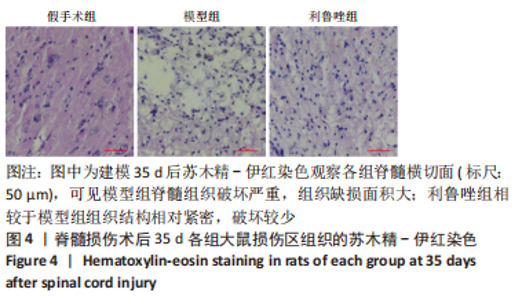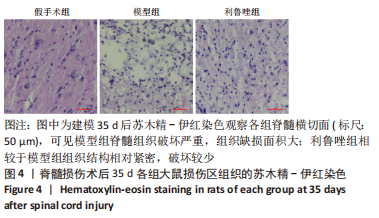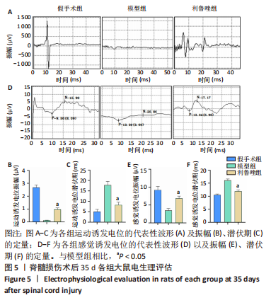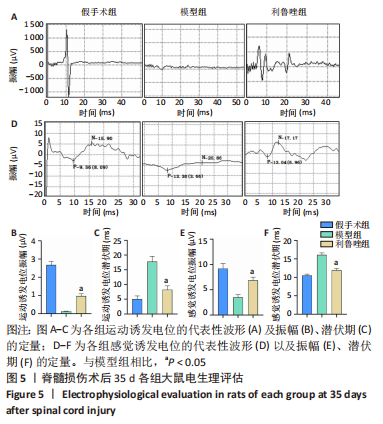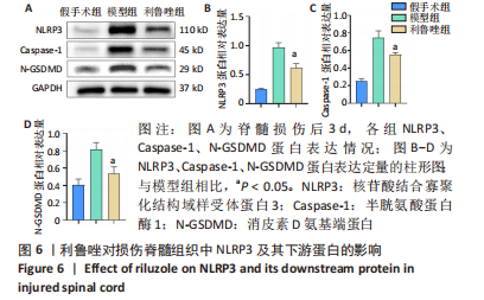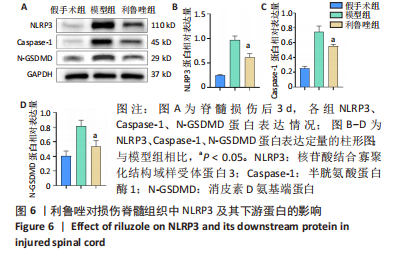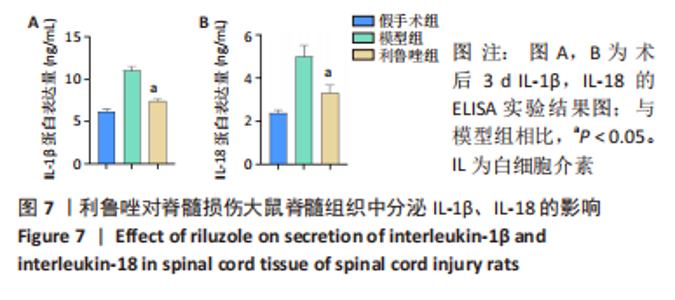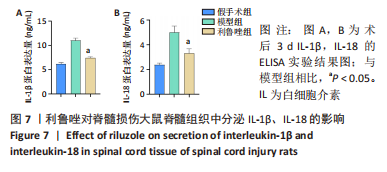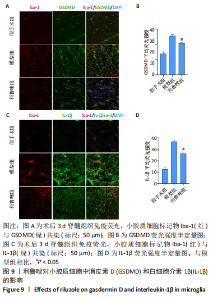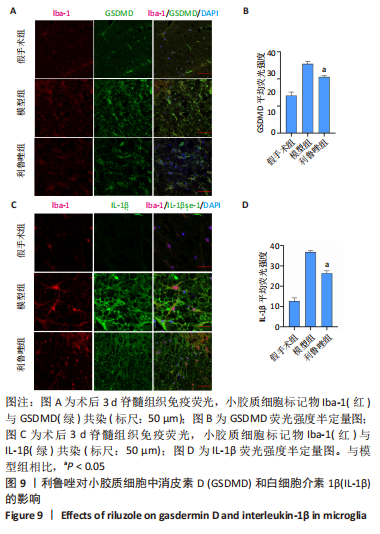Chinese Journal of Tissue Engineering Research ›› 2024, Vol. 28 ›› Issue (7): 1036-1042.doi: 10.12307/2024.127
Previous Articles Next Articles
Riluzole interferes with the activation of NLRP3 inflammasome in microglia of rats with spinal cord injury
Liu Tao, Zhang Wenkai, Ma Ziqian, Zhang Yan, Chen Xueming
- Department of Orthopedics, Beijing Luhe Hospital, Capital Medical University, Beijing 101100, China
-
Received:2023-01-18Accepted:2023-04-08Online:2024-03-08Published:2023-07-15 -
Contact:Chen Xueming, MD, Chief physician, Associate professor, Department of Orthopedics, Beijing Luhe Hospital, Capital Medical University, Beijing 101100, China -
About author:Liu Tao, Master candidate, Department of Orthopedics, Beijing Luhe Hospital, Capital Medical University, Beijing 101100, China Zhang Wenkai, Master, Department of Orthopedics, Beijing Luhe Hospital, Capital Medical University, Beijing 101100, China -
Supported by:Beijing Tongzhou District High-Level Talents Development Support Program - Leading Top Talents, No. YHDJ2019007 (to CXM)
CLC Number:
Cite this article
Liu Tao, Zhang Wenkai, Ma Ziqian, Zhang Yan, Chen Xueming. Riluzole interferes with the activation of NLRP3 inflammasome in microglia of rats with spinal cord injury[J]. Chinese Journal of Tissue Engineering Research, 2024, 28(7): 1036-1042.
share this article
Add to citation manager EndNote|Reference Manager|ProCite|BibTeX|RefWorks
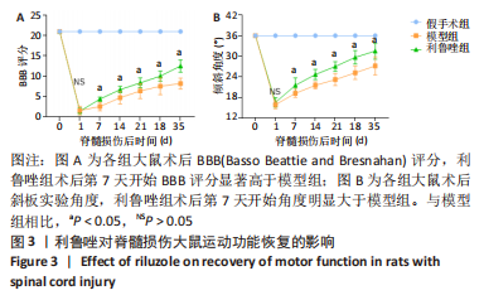
2.1 实验动物数量分析 36只雌性SD大鼠随机分为假手术组、模型组、利鲁唑组,每组12只。打击完脊髓后立即出现双后肢抽搐、摆尾,脊髓打击区域出现血肿,苏醒后双后肢自主运动功能消失。36只大鼠术后均未死亡。行脊髓打击的模型组、利鲁唑组大鼠术后前2 d出现血尿,后正常,无脓性分泌物,无感染迹象。 2.2 利鲁唑改善脊髓损伤大鼠后肢运动功能恢复 SD大鼠术前 BBB 评分均为满分,术后无意外死亡。除假手术组外,其余2组大鼠术后 1 d均呈截瘫状态,后肢运动功能丧失,靠前肢爬行,BBB 评分为 0 分;从术后1周起,大鼠后肢功能开始恢复,利鲁唑组大鼠术后第 1-5 周的 BBB 评分每个时间点均高于模型组 (P < 0.05),见图3A。斜板实验结果显示出了同样趋势,利鲁唑显著提高了大鼠保持稳定的倾斜角度(P < 0.05),见图3B。结果说明利鲁唑可促进脊髓损伤大鼠后肢运动功能恢复。"
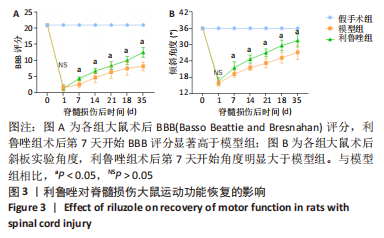
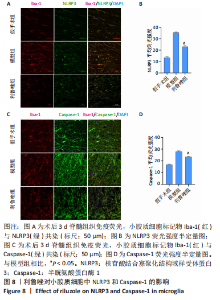
2.7 利鲁唑抑制损伤脊髓组织中小胶质细胞焦亡 用NLRP3联合小胶质细胞标记物Iba1免疫荧光共染色检测利鲁唑是否影响脊髓损伤后的小胶质细胞中炎性小体活化。模型组大鼠在损伤后3 d,损伤核心区域双标记NLRP3+/Iba1+细胞的荧光强度明显高于利鲁唑治疗的脊髓损伤大鼠(图8A,B)。为了进一步确定利鲁唑对小胶质细胞焦亡的影响,在造模后3 d免疫荧光染色检测了Caspase-1/GSDMD/IL-1β在小胶质细胞中的表达水平。结果显示,模型组双标记Caspase-1+/Iba1+细胞在脊髓损伤后第3天的荧光强度明显高于利鲁唑组(图8C,D)。作为焦亡主要执行蛋白的GSDMD和主要释放的炎症因子IL-1β在脊髓损伤后3 d表现出与Caspase-1相似的变化(图9)。这表明利鲁唑可抑制损伤脊髓中小胶质细胞中NLRP3炎性小体的活化,并可减轻小胶质细胞焦亡。"
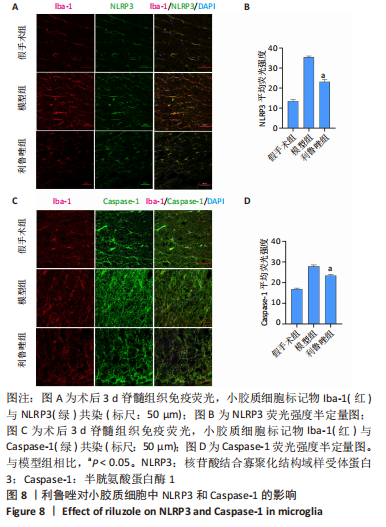
| [1] KHORASANIZADEH M, YOUSEFIFARD M, ESKIAN M, et al. Neurological recovery following traumatic spinal cord injury: a systematic review and meta-analysis. J Neurosurg Spine. 2019:1-17. [2] KUMAR H, ROPPER AE, LEE SH, et al. Propitious Therapeutic Modulators to Prevent Blood-Spinal Cord Barrier Disruption in Spinal Cord Injury. Mol Neurobiol. 2017;54(5):3578-3590. [3] FAN B, WEI Z, YAO X, et al. Microenvironment Imbalance of Spinal Cord Injury. Cell Transplant. 2018;27(6):853-866. [4] CHEN YX, ZULIYAER T, LIU B, et al. Sodium selenite promotes neurological function recovery after spinal cord injury by inhibiting ferroptosis. Neural Regen Res. 2022;17(12):2702-2709. [5] 王臣健,陈春晓,徐涛,等. 阿魏酸钠对大鼠脊髓损伤中NLRP3炎性小体的影响及机制[J]. 中国脊柱脊髓杂志,2021,31(8):739-748. [6] MCKENZIE BA, DIXIT VM, POWER C. Fiery Cell Death: Pyroptosis in the Central Nervous System. Trends Neurosci. 2020;43(1):55-73. [7] 高书涛,荀传辉,盛伟斌. NLRP3炎症小体在创伤性脊髓损伤中作用的研究进展[J]. 中国脊柱脊髓杂志,2019,29(11):1042-1045. [8] DE RIVERO VACCARI JP, LOTOCKI G, MARCILLO AE, et al. A molecular platform in neurons regulates inflammation after spinal cord injury. J Neurosci. 2008;28(13):3404-3414. [9] TRENDELENBURG G. Molecular regulation of cell fate in cerebral ischemia: role of the inflammasome and connected pathways. J Cereb Blood Flow Metab. 2014;34(12):1857-1867. [10] DISABATO DJ, QUAN N, GODBOUT JP. Neuroinflammation: the devil is in the details. J Neurochem. 2016;139 Suppl 2:136-153. [11] GAUDET AD, FONKEN LK. Glial Cells Shape Pathology and Repair After Spinal Cord Injury. Neurotherapeutics. 2018;15(3):554-577. [12] ZHAO H, WANG X, LIU S, et al. Paeonol regulates NLRP3 inflammasomes and pyroptosis to alleviate spinal cord injury of rat. BMC Neurosci. 2022;23(1):16. [13] VERMA SK, ARORA I, JAVED K, et al. Enhancement in the Neuroprotective Power of Riluzole Against Cerebral Ischemia Using a Brain Targeted Drug Delivery Vehicle. ACS Appl Mater Interfaces. 2016;8(30):19716-19723. [14] XU S, WU Q, ZHANG W, et al. Riluzole Promotes Neurite Growth in Rats after Spinal Cord Injury through the GSK-3β/CRMP-2 Pathway. Biol Pharm Bull. 2022;45(5):569-575. [15] XU J, HE J, HE H, et al. Comparison of RNAi NgR and NEP1-40 in Acting on Axonal Regeneration After Spinal Cord Injury in Rat Models. Mol Neurobiol. 2017;54(10):8321-8331. [16] WHITE-SCHENK D, SHI R, LEARY JF. Nanomedicine strategies for treatment of secondary spinal cord injury. Int J Nanomedicine. 2015; 10:923-938. [17] FAN B, WEI Z, FENG S. Progression in translational research on spinal cord injury based on microenvironment imbalance. Bone Res. 2022;10(1):35. [18] WU J, ZHAO Z, SABIRZHANOV B, et al. Spinal cord injury causes brain inflammation associated with cognitive and affective changes: role of cell cycle pathways. J Neurosci. 2014;34(33):10989-11006. [19] XU S, WANG J, ZHONG J, et al. CD73 alleviates GSDMD-mediated microglia pyroptosis in spinal cord injury through PI3K/AKT/Foxo1 signaling. Clin Transl Med. 2021;11(1):e269. [20] AL MAMUN A, WU Y, MONALISA I, et al. Role of pyroptosis in spinal cord injury and its therapeutic implications. J Adv Res. 2021;28:97-109. [21] LU F, LAN Z, XIN Z, et al. Emerging insights into molecular mechanisms underlying pyroptosis and functions of inflammasomes in diseases. J Cell Physiol. 2020;235(4):3207-3221. [22] JI X, SONG Z, HE J, et al. NIMA-related kinase 7 amplifies NLRP3 inflammasome pro-inflammatory signaling in microglia/macrophages and mice models of spinal cord injury. Exp Cell Res. 2021;398(2): 112418. [23] FAVERO FM, VOOS MC, CASTRO I, et al. Epidemiological and clinical factors impact on the benefit of riluzole in the survival rates of patients with ALS. Arq Neuropsiquiatr. 2017;75(8):515-522. [24] 吴启超,张妍,张雯秀,等. 利鲁唑治疗脊髓损伤的研究进展[J]. 中国康复理论与实践,2018,24(6):650-653. [25] OYINBO CA. Secondary injury mechanisms in traumatic spinal cord injury: a nugget of this multiply cascade. Acta neurobiologiae experimentalis. 2011;71(2):281-299. [26] MORTEZAEE K, KHANLARKHANI N, BEYER C, et al. Inflammasome: Its role in traumatic brain and spinal cord injury. J Cell Physiol. 2018; 233(7):5160-5169. [27] ABULAFIA DP, DE RIVERO VACCARI JP, LOZANO JD, et al. Inhibition of the inflammasome complex reduces the inflammatory response after thromboembolic stroke in mice. J Cereb Blood Flow Metab. 2009; 29(3):534-544. [28] ADAMCZAK SE, DE RIVERO VACCARI JP, DALE G, et al. Pyroptotic neuronal cell death mediated by the AIM2 inflammasome. J Cereb Blood Flow Metab. 2014;34(4):621-629. [29] TSUCHIYA K. Inflammasome-associated cell death: Pyroptosis, apoptosis, and physiological implications. Microbiol Immunol. 2020; 64(4):252-269. [30] ZHOU Y, WEN LL, LI YF, et al. Exosomes derived from bone marrow mesenchymal stem cells protect the injured spinal cord by inhibiting pericyte pyroptosis. Neural Regen Res. 2022;17(1):194-202. [31] LEHNARDT S. Innate immunity and neuroinflammation in the CNS: the role of microglia in Toll-like receptor-mediated neuronal injury. Glia. 2010;58(3):253-263. [32] DAVID S, KRONER A. Repertoire of microglial and macrophage responses after spinal cord injury. Nat Rev Neurosci. 2011;12(7):388-399. [33] WALSH JG, MURUVE DA, POWER C. Inflammasomes in the CNS. Nat Rev Neurosci. 2014;15(2):84-97. [34] ALBORNOZ EA, WOODRUFF TM, GORDON R. Inflammasomes in CNS Diseases. Exp Suppl. 2018;108:41-60. |
| [1] | Zeng Fanzhuo, Li Yuxin, Sun Jiachen, Gu Xinyang, Wen Shan, Tian He, Mei Xifan. Efficient strategies for microglia replacement in spinal cord injury models [J]. Chinese Journal of Tissue Engineering Research, 2024, 28(7): 1007-1014. |
| [2] | Chen Zepeng, Hou Yonghui, Chen Shudong, Hou Yu, Lin Dingkun. Tauroursodeoxycholic acid treats spinal cord injury by reducing apoptosis of spinal cord neurons under glucose and oxygen deprivation [J]. Chinese Journal of Tissue Engineering Research, 2024, 28(4): 528-534. |
| [3] | Zheng Mingkui, Xue Chenhui, Guan Xiaoming, Ma Xun. Human umbilical cord mesenchymal stem cell-derived exosomes reduce the permeability of blood-spinal cord barrier after spinal cord injury [J]. Chinese Journal of Tissue Engineering Research, 2024, 28(1): 50-55. |
| [4] | Zhao Quanwei, Li Hui, Liu Danan, Gong Caiwei, Chen Long. Dapagliflozin attenuates endothelial cell pyroptosis and dysfunction induced by oxidized low-density lipoprotein [J]. Chinese Journal of Tissue Engineering Research, 2024, 28(1): 80-85. |
| [5] | Long Qingxi, Zhang Pingshu, Liu Qing, Ou Ya, Zhang Lili, Yuan Xiaodong. Single-cell RNA sequencing reveals the heterogeneity of astrocytes [J]. Chinese Journal of Tissue Engineering Research, 2024, 28(1): 139-146. |
| [6] | Guo Shuhui, Yang Ye, Jiang Yangyang, Xu Jianwen. Screening and validation of neurogenic bladder miRNA-mRNA regulatory network [J]. Chinese Journal of Tissue Engineering Research, 2023, 27(在线): 1-8. |
| [7] | He Wanyu, Cheng Leping. Strategies and advance on stem cell transplantation for repair of spinal cord injury [J]. Chinese Journal of Tissue Engineering Research, 2023, 27(在线): 1-7. |
| [8] | Yang Jiujie, Li Zhi, Wang Shujie, Tian Ye, Zhao Wei. Intraoperative neurophysiological monitoring of functional changes following durotomy with decompression for acute spinal cord injury [J]. Chinese Journal of Tissue Engineering Research, 2023, 27(8): 1232-1236. |
| [9] | Gao Yu, Han Jiahui, Ge Xin. Immunoinflammatory microenvironment after spinal cord ischemia-reperfusion injury [J]. Chinese Journal of Tissue Engineering Research, 2023, 27(8): 1300-1305. |
| [10] | Hao Liufang, Duan Hongmei, Wang Zijue, Hao Fei, Hao Peng, Zhao Wen, Gao Yudan, Yang Zhaoyang, Li Xiaoguang. Spatiotemporal dynamic changes of ependymal cells after spinal cord injury in transgenic mice [J]. Chinese Journal of Tissue Engineering Research, 2023, 27(6): 883-889. |
| [11] | Li Xiaoyin, Yang Xiaoqing, Chen Shulian, Li Zhengchao, Wang Ziqi, Song Zhen, Zhu Daren, Chen Xuyi. Collagen/silk fibroin scaffold combined with neural stem cells in the treatment of traumatic spinal cord injury [J]. Chinese Journal of Tissue Engineering Research, 2023, 27(6): 890-896. |
| [12] | Zhang Qijian, Xu Ximing. Acquisition and application of ectodermal mesenchymal stem cells [J]. Chinese Journal of Tissue Engineering Research, 2023, 27(6): 928-934. |
| [13] | Li Zhichao, Tan Guoqing, Su Hui, Xu Zhanwang, Xue Haipeng. Regulatory role of non-coding RNAs as potential therapeutic targets in spinal cord injury [J]. Chinese Journal of Tissue Engineering Research, 2023, 27(5): 758-764. |
| [14] | Tao Xin, Xu Yi, Song Zhiwen, Liu Jinbo. Hippo signaling pathway in the regulation of spinal cord injury [J]. Chinese Journal of Tissue Engineering Research, 2023, 27(4): 619-625. |
| [15] | Ding Yiqun, Li Xigong, Pan Wenming, Zhang Qin. Role and advance of mitophagy in spinal cord injury [J]. Chinese Journal of Tissue Engineering Research, 2023, 27(35): 5727-5733. |
| Viewed | ||||||
|
Full text |
|
|||||
|
Abstract |
|
|||||
